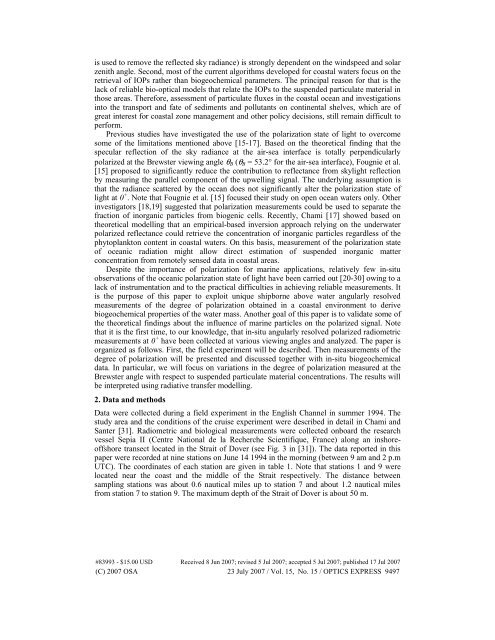Determination of biogeochemical properties of marine particles ...
Determination of biogeochemical properties of marine particles ...
Determination of biogeochemical properties of marine particles ...
Create successful ePaper yourself
Turn your PDF publications into a flip-book with our unique Google optimized e-Paper software.
is used to remove the reflected sky radiance) is strongly dependent on the windspeed and solar<br />
zenith angle. Second, most <strong>of</strong> the current algorithms developed for coastal waters focus on the<br />
retrieval <strong>of</strong> IOPs rather than <strong>biogeochemical</strong> parameters. The principal reason for that is the<br />
lack <strong>of</strong> reliable bio-optical models that relate the IOPs to the suspended particulate material in<br />
those areas. Therefore, assessment <strong>of</strong> particulate fluxes in the coastal ocean and investigations<br />
into the transport and fate <strong>of</strong> sediments and pollutants on continental shelves, which are <strong>of</strong><br />
great interest for coastal zone management and other policy decisions, still remain difficult to<br />
perform.<br />
Previous studies have investigated the use <strong>of</strong> the polarization state <strong>of</strong> light to overcome<br />
some <strong>of</strong> the limitations mentioned above [15-17]. Based on the theoretical finding that the<br />
specular reflection <strong>of</strong> the sky radiance at the air-sea interface is totally perpendicularly<br />
polarized at the Brewster viewing angle θ B (θ B = 53.2° for the air-sea interface), Fougnie et al.<br />
[15] proposed to significantly reduce the contribution to reflectance from skylight reflection<br />
by measuring the parallel component <strong>of</strong> the upwelling signal. The underlying assumption is<br />
that the radiance scattered by the ocean does not significantly alter the polarization state <strong>of</strong><br />
light at 0 + . Note that Fougnie et al. [15] focused their study on open ocean waters only. Other<br />
investigators [18,19] suggested that polarization measurements could be used to separate the<br />
fraction <strong>of</strong> inorganic <strong>particles</strong> from biogenic cells. Recently, Chami [17] showed based on<br />
theoretical modelling that an empirical-based inversion approach relying on the underwater<br />
polarized reflectance could retrieve the concentration <strong>of</strong> inorganic <strong>particles</strong> regardless <strong>of</strong> the<br />
phytoplankton content in coastal waters. On this basis, measurement <strong>of</strong> the polarization state<br />
<strong>of</strong> oceanic radiation might allow direct estimation <strong>of</strong> suspended inorganic matter<br />
concentration from remotely sensed data in coastal areas.<br />
Despite the importance <strong>of</strong> polarization for <strong>marine</strong> applications, relatively few in-situ<br />
observations <strong>of</strong> the oceanic polarization state <strong>of</strong> light have been carried out [20-30] owing to a<br />
lack <strong>of</strong> instrumentation and to the practical difficulties in achieving reliable measurements. It<br />
is the purpose <strong>of</strong> this paper to exploit unique shipborne above water angularly resolved<br />
measurements <strong>of</strong> the degree <strong>of</strong> polarization obtained in a coastal environment to derive<br />
<strong>biogeochemical</strong> <strong>properties</strong> <strong>of</strong> the water mass. Another goal <strong>of</strong> this paper is to validate some <strong>of</strong><br />
the theoretical findings about the influence <strong>of</strong> <strong>marine</strong> <strong>particles</strong> on the polarized signal. Note<br />
that it is the first time, to our knowledge, that in-situ angularly resolved polarized radiometric<br />
measurements at 0 + have been collected at various viewing angles and analyzed. The paper is<br />
organized as follows. First, the field experiment will be described. Then measurements <strong>of</strong> the<br />
degree <strong>of</strong> polarization will be presented and discussed together with in-situ <strong>biogeochemical</strong><br />
data. In particular, we will focus on variations in the degree <strong>of</strong> polarization measured at the<br />
Brewster angle with respect to suspended particulate material concentrations. The results will<br />
be interpreted using radiative transfer modelling.<br />
2. Data and methods<br />
Data were collected during a field experiment in the English Channel in summer 1994. The<br />
study area and the conditions <strong>of</strong> the cruise experiment were described in detail in Chami and<br />
Santer [31]. Radiometric and biological measurements were collected onboard the research<br />
vessel Sepia II (Centre National de la Recherche Scientifique, France) along an inshore<strong>of</strong>fshore<br />
transect located in the Strait <strong>of</strong> Dover (see Fig. 3 in [31]). The data reported in this<br />
paper were recorded at nine stations on June 14 1994 in the morning (between 9 am and 2 p.m<br />
UTC). The coordinates <strong>of</strong> each station are given in table 1. Note that stations 1 and 9 were<br />
located near the coast and the middle <strong>of</strong> the Strait respectively. The distance between<br />
sampling stations was about 0.6 nautical miles up to station 7 and about 1.2 nautical miles<br />
from station 7 to station 9. The maximum depth <strong>of</strong> the Strait <strong>of</strong> Dover is about 50 m.<br />
#83993 - $15.00 USD Received 8 Jun 2007; revised 5 Jul 2007; accepted 5 Jul 2007; published 17 Jul 2007<br />
(C) 2007 OSA 23 July 2007 / Vol. 15, No. 15 / OPTICS EXPRESS 9497
















